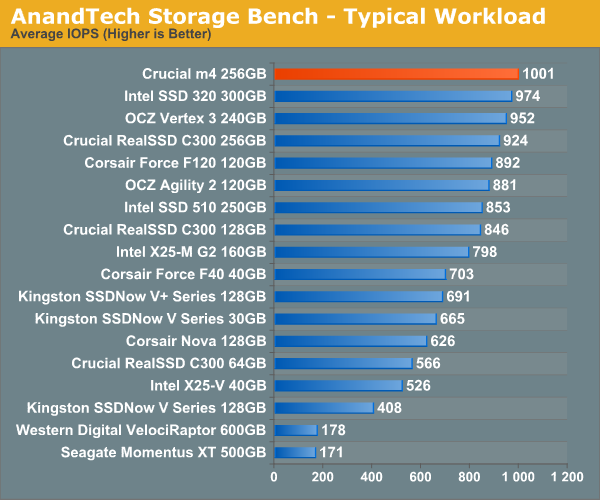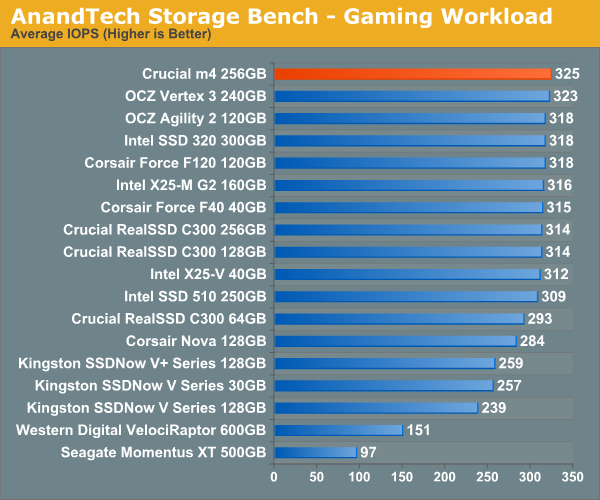The Crucial m4 (Micron C400) SSD Review
by Anand Lal Shimpi on March 31, 2011 3:16 AM ESTAnandTech Storage Bench 2010
To keep things consistent we've also included our older Storage Bench. Note that the old storage test system doesn't have a SATA 6Gbps controller, so we only have 3Gbps results for the 6Gbps drives.
The first in our benchmark suite is a light/typical usage case. The Windows 7 system is loaded with Firefox, Office 2007 and Adobe Reader among other applications. With Firefox we browse web pages like Facebook, AnandTech, Digg and other sites. Outlook is also running and we use it to check emails, create and send a message with a PDF attachment. Adobe Reader is used to view some PDFs. Excel 2007 is used to create a spreadsheet, graphs and save the document. The same goes for Word 2007. We open and step through a presentation in PowerPoint 2007 received as an email attachment before saving it to the desktop. Finally we watch a bit of a Firefly episode in Windows Media Player 11.
There’s some level of multitasking going on here but it’s not unreasonable by any means. Generally the application tasks proceed linearly, with the exception of things like web browsing which may happen in between one of the other tasks.
The recording is played back on all of our drives here today. Remember that we’re isolating disk performance, all we’re doing is playing back every single disk access that happened in that ~5 minute period of usage. The light workload is composed of 37,501 reads and 20,268 writes. Over 30% of the IOs are 4KB, 11% are 16KB, 22% are 32KB and approximately 13% are 64KB in size. Less than 30% of the operations are absolutely sequential in nature. Average queue depth is 6.09 IOs.
The performance results are reported in average I/O Operations per Second (IOPS):

Lighter read-heavy workloads do very well on the m4. Thankfully for Crucial, most user workloads tend to be very read intensive. Over a 3Gbps interface, the m4 is a bit faster than Intel's 320 in our typical workload from 2010.
If there’s a light usage case there’s bound to be a heavy one. In this test we have Microsoft Security Essentials running in the background with real time virus scanning enabled. We also perform a quick scan in the middle of the test. Firefox, Outlook, Excel, Word and Powerpoint are all used the same as they were in the light test. We add Photoshop CS4 to the mix, opening a bunch of 12MP images, editing them, then saving them as highly compressed JPGs for web publishing. Windows 7’s picture viewer is used to view a bunch of pictures on the hard drive. We use 7-zip to create and extract .7z archives. Downloading is also prominently featured in our heavy test; we download large files from the Internet during portions of the benchmark, as well as use uTorrent to grab a couple of torrents. Some of the applications in use are installed during the benchmark, Windows updates are also installed. Towards the end of the test we launch World of Warcraft, play for a few minutes, then delete the folder. This test also takes into account all of the disk accesses that happen while the OS is booting.
The benchmark is 22 minutes long and it consists of 128,895 read operations and 72,411 write operations. Roughly 44% of all IOs were sequential. Approximately 30% of all accesses were 4KB in size, 12% were 16KB in size, 14% were 32KB and 20% were 64KB. Average queue depth was 3.59.

Last year's heavy multitasking workload was also predominantly read heavy. The m4 does very well here again, roughly equaling the performance of OCZ's Vertex 3.
The gaming workload is made up of 75,206 read operations and only 4,592 write operations. Only 20% of the accesses are 4KB in size, nearly 40% are 64KB and 20% are 32KB. A whopping 69% of the IOs are sequential, meaning this is predominantly a sequential read benchmark. The average queue depth is 7.76 IOs.

Gaming performance is good but we're of course bottlenecked by the 3Gbps SATA interface in this test.










103 Comments
View All Comments
Chloiber - Thursday, March 31, 2011 - link
I'm a bit curious why I can't see any word on the last page on the strange sequential performance behaviour. AS SSD and in a way also PCMark Vantage show, that the m4 is very fast in sequential read. Why this huge difference? I'm not expecting an answer, but I expected a word on that on the last page. It it's very strange.iwod - Thursday, March 31, 2011 - link
Which means for majority of users, if you have Windows 7 , trim, m4 will properly be the best SSD to get.I wish they could bring down the price of their 60GB.......
ekerazha - Thursday, March 31, 2011 - link
The best is Vertex 3, my only concern is its power consumption.Kepe - Thursday, March 31, 2011 - link
SSD power consumption is very low compared to what CPUs and GPUs consume. I don't quite understand why an idle power consumption of 1,8 watts and load power consumption of ~4 watts would be such a big deal.The Vertex 3 probably consumes more power because the controller needs to do a bit more processing than other controllers do, with all those compression algorithms going on.
ekerazha - Thursday, March 31, 2011 - link
It is more power hungry than the Seagate HDD, on a desktop system it isn't a problem, but I'm concerned about using it on laptops.beginner99 - Thursday, March 31, 2011 - link
Yeah I always thought ssds use much less power but it doesn't really seem to be so.jcandle - Thursday, March 31, 2011 - link
Even in a performance notebook its a non-issue. I just wouldn't choose it for an ultraportable. But then I wouldn't been looking for best performance. Just a large SSD with best bang-for-the-buck would be the right balance. Having too much HDD speed when the system itself is holding you back doesn't help.taltamir - Thursday, March 31, 2011 - link
if you compare it to a 2.5" low RPM HDD, and only look at the watts/second then you might think so.but consider the power/work done also. Doing work takes time, it takes less time with the SSD, which makes it go idle sooner, which prolongs battery life.
that being said, 1.8 watt idle is rather high for a solid state device
Mr Perfect - Thursday, March 31, 2011 - link
That's a good point. Mechanical drives, especially the low power 2.5" ones, spend a lot of time thrashing around. SSDs, on the other hand, load your data in a snap and go right back to idle mode.It would make for an interesting battery test.
djgandy - Thursday, March 31, 2011 - link
The Seagate is a bit of a poor comparison as it is hybrid. The WD Raptor is the complete other extreme.A normal, run of the mill hard drive would be nice for comparison.